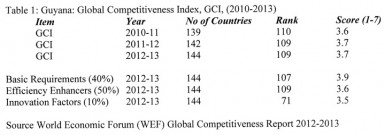Scope
This week I shall conclude the discussion on the selection of public projects in Guyana and their sequencing. While I have referred repeatedly in this discussion to the requirement to appraise projects ex ante (that is, before they are selected by the Authorities), readers should not infer from this observation that such appraisals should be exclusively economic and financial. Consistent with observations I have made in previous columns, these appraisals are expected to be much wider in scope. Indeed, in every instance they should be accompanied with three other sets of evaluations. These are: first, social and environmental assessments (ESIAs), which must be compulsory and made publicly available. This requirement exists in most other countries where there can be found a strong and growing practice of undertaking ESIAs. In Guyana, under the auspices of the Environmental Protection Agency (EPA), this is a growing practice as well in the case of public projects.

Appraising projects along the lines indicated above constitutes only one part of the management of Phase 2 (project selection and sequencing) of the public investment programme. These appraisals ensure that public investment projects are not treated as stand-alone activities. Such projects are required to be integrated into Guyana’s National Budget cycle, since the National Budget is the principal vehicle for integrating Government’s plans into their recurrent and capital spending requirements. In turn, this requirement further locates the National Budget into a multi-year medium-term framework (our present National Budget process already seeks to do this). It should also be noted this approach allows for both the integration of donor-funded projects as well as those projects that are specific to particular sectors and/or state-owned enterprises, in a coherent and timely manner. These aspects of Guyana’s management of public investment projects will be discussed further when I deal with Phase 3 of the process where the emphasis is placed on the timeliness of projects; the avoidance of delays and cost overruns; and, other manifestations of mismanagement, waste and inefficiency.
Guyana’s competitiveness
Worldwide, the bulk of public investment projects have been located in the infrastructure and energy sector. Here infrastructure refers to physical infrastructure (transport and communications; drainage and irrigation etc); economic infrastructure (markets, ports, etc); social infrastructure (schools, health); and, institutional infrastructure (regulatory institutions, other state institutions). Where there are major state-owned commercial enterprises, such as Guysuco, their investment profiles are often guided and directly supported by the government.
Because of this particular focus of public investments, the “engine” of economic growth in the output of goods and services (based on the country’s infrastructure) is the main preserve of the private and other “non-state” sectors (cooperatives and non-profits). One of the overarching goals behind the emphasis on the public provision of infrastructure investment is to bolster the country’s capacity to compete in the global economy.
At this stage it would be useful therefore, to observe Guyana’s reported competitiveness in the global economy. The World Economic Forum (WEF) published its Global Competitiveness Report for 2012-13 and Guyana’s status is shown in Table 1 below.
Based on a ranking score of 1-7, Guyana scored 3.9. In the Table these data are further broken down into three areas or components of competitiveness. First, there are basic requirements, which comprise institutions, infrastructure, macroeconomic environment, health and primary education. These account for 40 per cent of the score. Second there are efficiency enhancers, which include higher education and training, goods and labour market efficiency, financial development and market size. This accounts for 50 per cent of the score. And, third there are innovation factors, which include business sophistication and innovation. These account for 10 per cent of the score. These areas of competitiveness reflect (as well as determine) the comparative stage of development of Guyana’s economy on a global level.
Table 2 below reveals some related information on the Guyana economy. I have rearranged the WEF’s survey data to categorise the six leading “items” which survey respondents identify as the most problematic factors affecting “doing business” in Guyana. Persons familiar with Guyana would not be surprised to observe that respondents believe the item classed as “crime /theft/corruption”/leads the way with 38 per cent of the responses! The next five “items” are also not surprising: workforce-related (16.8 per cent); government-related (15.8 per cent); tax related (12 per cent); access to financing (10.1 per cent); and, infrastructure (4.3 per cent).
Table 2: Leading Problematic Factors for Doing Business in Guyana, 2012-2013
Item % of Responses
Crime/theft/corruption 38.3
Workforce related (work ethic/education/labour regulations) 16.8
Government-related (bureaucracy/instability/ policy/inflation, Public health) 15.8
Tax-related 12.0
Access to Financing 10.1
Infrastructure 4.3
Source: WEF 2012-13





